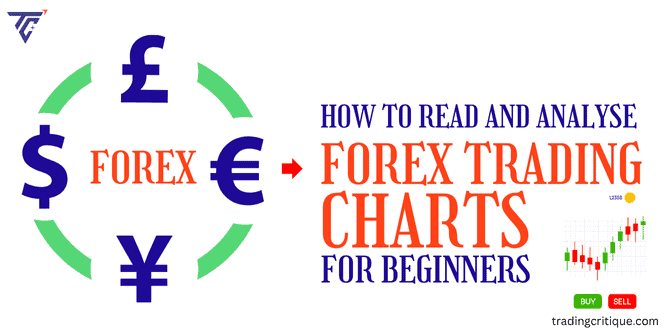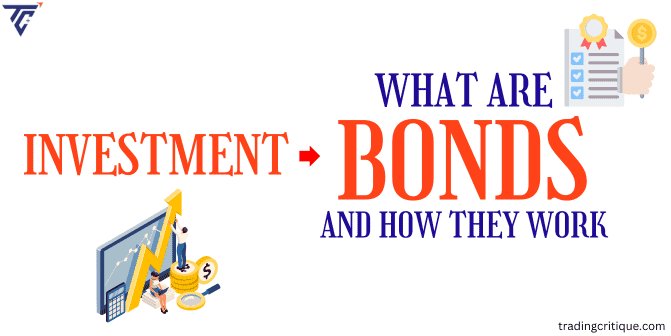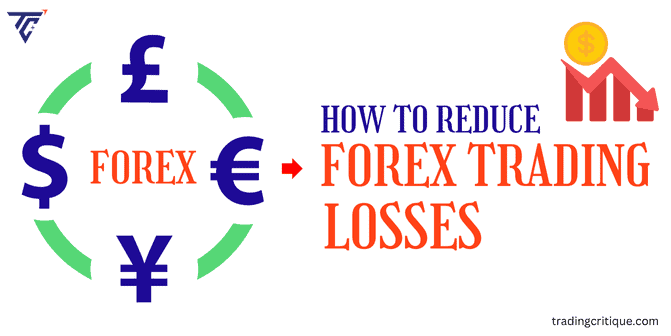How to Read Forex Charts For Beginners – Simple Methods
Knowing how to read a forex chart is the first step a person takes to trade forex. A technical chart helps a trader study the currency pair price movements for a period of time. There are numerous types of charts and the few important ones are below:
- Candlesticks charts
- Bar charts
- Line charts etc.
Traders look for the currency pair price movements, their patterns, and their tendencies in order to predict future moves. There are no hard and fast rules to select the chart type because each chart has its own advantages and disadvantages.

Quick Insights
Reading the price charts is the base for forex trading. There are numerous ways of representing information in the charts.
Along with fundamental analysis, a trader needs to pay attention to technical analysis as well in order to have full-fledged research.
How to read forex charts?
A forex chart is a visual representation of real-time price moves and the trading activity of the currency pairs over a set period of time. How to read forex charts involves learning the charting methods including enormous indicators and advanced tools that effectively help traders forecast price movements. There is a proper way to read a chart.
- Prices are plotted from left to right.
- Since the chart depicts every buy and sell price of the currency pairs, you can view every price at any given time frame. There are options to choose the different time frames such as monthly, hourly, weekly, yearly, etc.
Though the data are the same, the ways of presenting and interpreting differ for each type of chart. The reading style also differs for each chart pattern. Below are a few of the most important charting patterns commonly used.
Candlestick chart
Candlestick charts are nothing but a variation of bar charts, in fact, the upgraded version of bar charts. Though these charts show the same price details as the bar chart, candlesticks differ in terms of their graphic representation.
Every candle represents the high, low, open, and close prices of the currency pair for the chosen time period. The time frame can be hourly, daily, weekly, monthly, yearly, and more. The respective charts are called short-term, intermediate-term, and long-term according to the view of the traders.
The colors of the candlesticks are mostly green and red so that green can represent a positive close and red can represent a negative close of the currency price. When the currency pair closes above the opening price, we call it a positive close of the day and the candle takes a green color. When the currency pair closes below its opening price, we call it a negative close of the day and the candle takes a red color.
- Open – Opening price
- Close – Closing price
- High – Highest price of the day
- Low – Lowest price of the day
There are numerous candlestick patterns that signal buying or selling. For example, a shooting star in the uptrend signals the end of the trend. A double bottom in a downtrend signals trend reversal.
The only drawback in candlestick charts is, they don’t provide information on whether the high or the low that was reached first.
Bar chart
Bar charts were so familiar among the traders till the existence of candlestick charts. Bar charts are more similar to candlestick charts in terms of depicting high, low, open, and close prices.
It is easier to observe the expansion and contraction of the price ranges for a given period of time using bar charts than the others.
Line charts
The line chart is the simplest of all the other types and is very easy to read. Unlike the others, line charts depict only the closing prices of the currency pairs. To put it simply, a line connects a series of closing prices of all the days.
Line charts are ideal for new traders who look only for simplicity and clarity in charts. Before getting into advanced techniques, one can first go for line charts to get a grip on simple chart reading methods. However, line charts have become outdated nowadays due to the reason, they don’t provide the price highs & lows of the currency pairs.
How to analyze a forex chart?
In order to make good trading decisions, a trader should ensure he has enough information in the chart and set up the chart preferences accordingly. Though it is important to ensure he fully utilize all the possible resources, we cannot rule out the fact that the usage of too many charting tools may lead to flawed interpretations.
Any trade, without analyzing the chart is not fully analyzed. Here are a few suggestions on how to read a forex chart.
- Keep your chart as simple as possible. Using too many tools may not always lead to the right interpretations.
- The first thing to look into the chart is to recognize the underlying trend. This helps you to avoid trading against the prevailing trend.
- Take the support of momentum indicators to strengthen your decision.
Chart indicators
There are numerous chart indicators that help traders to get specific information on the price movements. A few of the commonly used indicators are below:
MACD
The Moving Average Convergence/Divergence is a momentum indicator that depicts the relationship between two moving averages of the currency pairs. It helps us to identify a new trend and verify if it is bearish or bullish.
RSI
The relative Strength Index is a momentum indicator that measures the speed of price change of the currency pairs. Using this tool, we can find if the currency pair is oversold or overbought.
Bollinger bands
Bollinger bands help us to measure the price volatility of the currency pairs and it helps us to determine the entry and exit points of your trade.
Fibonacci
Fibonacci indicates the direction of the market and the reversal of the trend to book profits and exit the trades. The Fibonacci retracement levels help us to find the areas, in which the markets may retrace before resuming the prevailing trend.
Pivot point
Pivot points help us to measure the balance between the demand and supply of the currency pairs.
Stochastic
Stochastic oscillator helps us to recognize the trends that are likely to reverse. It also identifies the momentum and overbought/oversold regions.
Advantages of charts
- A chart represents the supply and demand of the underlying asset.
- Charts are easy to interpret and the right place for beginners to start with.
- Charting tools help traders to measure volatility in the market.
- Charting patterns helps the traders to identify the trends and patterns and signals potential trend reversals.
- A trader cannot fix entry and exit points without the help of charts. However, knowledgeable experienced traders use fundamental analysis as well to confirm the technical signals shown in the chart.
Conclusion
With the help of the forex charts, one can obtain a comprehensive view of the market and identify potential trading opportunities. Experienced traders employ various types of forex charts to make an accurate market analysis. Thanks to the advent of modern graphic charts, they provide essential tools for understanding market trends.
Pro Tip
Learn the basics of forex chart analysis and how to interpret the charts for effective decision-making with our trusted forex brokers. Understand the usage of the right tools and charting indicators and how they add value to the charting techniques. You can rely on us not for just forex, but also for stocks, crypto, CFD, banking, and more.
Frequently Asked Questions
1. What is a price chart?
A price chart is a visual representation of the price movements of a financial instrument for a given period of time.
2. What is a forex chart?
A forex chart represents the price movements of specific currency pairs for a set period of time. X-axis shows the time and Y-axis shows the price.
3. What are support and resistance?
Support and resistance are the price levels at which the currency pairs are likely to reverse or make a breakout. Buying increases at support levels and selling increases at resistance levels. Prices respond to support and resistance levels as evidenced by the charts.

Subscribe to
Our Newsletter
Latest Posts
How to Trade Forex | Learn 6 Strategies and Tips
Discover the world of forex trading with our comprehensive guide. Learn essential...
Read MoreFP Markets Review 2024: Everything You Need To Know
Founded in 2005, FP Markets is a leading online broker renowned for...
Read MoreHow to Invest in Ethereum in 2024 – Simple Guide for Beginners
Ethereum is a decentralized blockchain platform that enables smart contracts, enabling secure,...
Read MoreIs Cryptocurrency a Safe Investment? What You Need To Know
Investing in cryptocurrency involves selecting the right cryptocurrency and securely storing your...
Read MoreHow to Read Forex Charts for Beginners • Simple Methods
Traders look for the currency pair price movements, their patterns, and their...
Read MoreBonds: What it is, Types of Bonds & How they Work (2024 guide)
Are you seeking for safe investment with predictable returns? Our 2024 guide...
Read MoreWhat are The Best Crypto Trading Strategies for Beginners in 2024?
Unsure about choosing the best trading strategies for beginners in 2024? This...
Read MoreForex Pairs: How They Work, How To Read, Examples
Forex pairs are combinations of two different currencies that are traded in...
Read MoreBest Ways to Avoid Losses in Forex Trading
Foreign Exchange – Forex market is the world’s largest financial market in...
Read More








